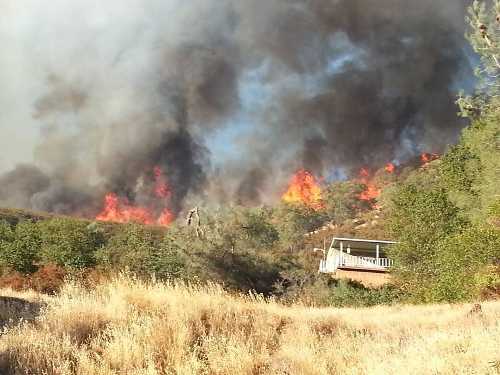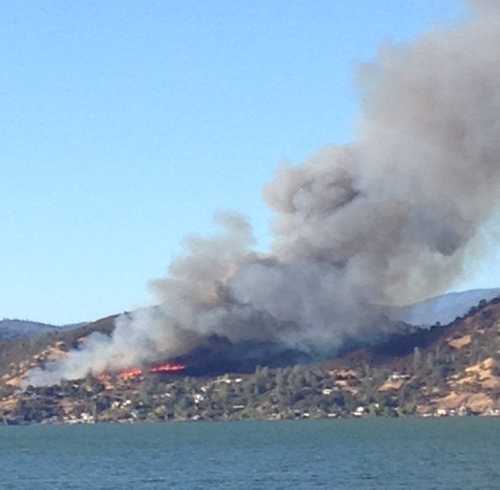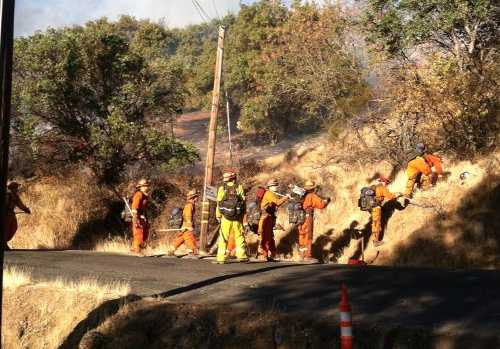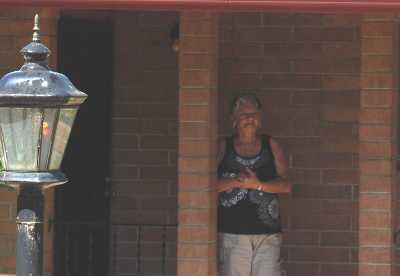LAKE COUNTY, Calif. – A Lake County Sheriff’s deputy who shot at a suspect in Clearlake Oaks in May was justified in doing so, according to a report released Friday by the District Attorney’s Office.
District Attorney Don Anderson said Deputy Lyle Thomas, a sheriff’s office veteran, “was justified in discharging his firearm at a suspect pointing what was believed to be a firearm at him,” during an incident that occurred on May 15.
Thomas responded to Fourth Street in Clearlake Oaks on the report of a woman having been shot with a pellet gun by 52-year-old Robert Scott Hisel, as Lake County News has reported.
Hisel came out of his residence armed with a pellet gun that had the appearance of an assault rifle. Thomas, who Anderson said knew of Hisel and the fact that he recently had been in possession of a firearm, had no way of knowing it was actually a pellet gun.
“From Deputy Thomas’ position he had every reason to believe he was about to be shot by a subject with a high-powered assault rifle,” Anderson said.
Hisel leveled the pellet gun at Thomas and the victim. Thomas grabbed the woman and pulled her to safety, using his own body as a shield, according to Anderson’s report.
Anderson said Hisel shot five rounds at Thomas with the pellet gun before going back into his home. Thomas didn’t return fire at that point but gave Hisel at least 35 commands to drop the pellet gun and come out of the residence.
Hisel “responded with profanity, threats and nonsensical comments,” Anderson reported.
Coming out to the front of his residence, Hisel refused to obey commands, became verbally aggressive and then reached into a fanny pack, pulling out a black handgun that appeared to be a Glock. Anderson said Thomas commanded Hisel to drop the gun several more times before Hisel pointed it at the deputy.
“In justifiable fear for his life and the life of others, Deputy Thomas fired five shots at the suspect. The suspect fired back at Deputy Thomas at which time the deputy heard the sounds of pellet rounds,” Anderson wrote.
Thomas saved Hisel’s life when he told an officer from an allied agency who had responded to the scene – and who had a clear shot at Hisel with a high-powered rifle – to hold his fire, Anderson said.
Hisel went back into his home, where he remained during a standoff with law enforcement that lasted several hours. The sheriff’s SWAT team took Hisel into custody shortly after 10:30 p.m.
The sheriff’s office reported at the time that Hisel suffered a small leg wound during the incident.
The day following the standoff, sheriff’s detectives found two grenades. the Napa County Sheriff’s Bomb Squad responded and detonated the grenades.
“Deputy Lyle Thomas committed no criminal acts in his conduct of May 15, 2013,” Anderson concluded. “In fact, he has shown extreme bravery and exhibited restraint, calm deliberation and professionalism in his actions that day.
Anderson’s final report is published in its entirety below.
Email Elizabeth Larson at This email address is being protected from spambots. You need JavaScript enabled to view it. . Follow her on Twitter, @ERLarson, or Lake County News, @LakeCoNews.
LAKE COUNTY DISTRICT ATTORNEY’S FINAL REPORT
OFFICER INVOLVED CRITICAL INCIDENT-DEPUTY LYLE THOMAS
MAY 15, 2013
SUMMARY
On May 15, 2013, at 4:25 p.m., Deputy Lyle Thomas, a veteran officer of the Lake County Sheriff’s Department, was involved in an officer-involved shooting on Fourth Street in Clearlake Oaks, Calif.
It is the finding of the Lake County District Attorney’s Office that Deputy Lyle Thomas was justified in discharging his firearm at a suspect pointing what was believed to be a firearm at him. Therefore, no criminal charges will be filed in this matter. In fact, Deputy Lyle Thomas’ bravery and exhibition of professionalism under fire should be commended by the citizens of Lake County.
In close review of the facts of this matter, two important lessons should be learned that can greatly improve the quality of law enforcement’s efforts. First, the extreme calm and intelligent mannerism exhibited by Deputy Thomas is a model of professionalism that should be taught and reviewed by officers throughout this state.
The second is a reinforcement of the need for an officer involved critical incident protocol that is strictly adhered to by every law enforcement agency in this county, in order to ensure the integrity of the investigation.
INVESTIGATION
In 1989 the Lake County Police Chief’s Association recognized the increasing needs of their departments and the public to have an effective and standardized system to investigate law enforcement involved critical/fatal incidents, and created the first Lake County Fatal Incident Protocol.
As technology and investigative techniques improved, and police agencies became more aware of the intricacies of these incidents, the Protocol was revised in 1998 and 2009. In January of 2013 the current version of the Lake County Critical Incident Protocol was signed and implemented by eight of the nine law enforcement agencies in Lake County.
Of the many facets of the Protocol, the District Attorney’s Office is the lead agency in the investigation. It is essential the DA’s Office be on the scene immediately to secure evidence; protect the rights of the officers; and ensure the public of an unbiased investigation into the facts of the critical incident.
In this matter, the District Attorney’s Office was not notified until after a full day had passed; therefore, some questions will go unanswered. With the cooperation of the investigators and patrolmen of the Sheriff’s Department; compelling physical evidence; and follow up investigation, there was enough data collected to make a determination in this case.
FACTS
On May 15, 2013, at 4:25 p.m. Deputy Lyle Thomas responded to Fourth Street in Clearlake Oaks to a report of a female being shot with a pellet gun by her neighbor. Deputy Thomas had prior knowledge of the suspect and knew he had recently been in possession of a firearm.
While Deputy Thomas was talking to the victim on Fourth Street the suspect came out of his residence with a pellet rifle. The rifle has the appearance of an assault rifle and the deputy had no way of actually knowing it was a pellet rifle. From Deputy Thomas’ position he had every reason to believe he was about to be shot by a subject with a high-powered assault rifle.
The suspect leveled the rifle and pointed it at Deputy Thomas and the victim. Despite his fear of immediately being shot, Deputy Thomas grabbed the victim and, using his own body as a shield, pulled the victim to safety.
A few seconds later the suspect fired a round at Deputy Thomas. At this time he was able to determine the suspect was in possession of a pellet rifle. The suspect fired four more rounds at Deputy Thomas before retreating inside his residence.
Despite the fact the suspect’s high powered pellet rifle can cause great bodily injury or death, Deputy Thomas did not return fire. Deputy Thomas gave the suspect at least 35 commands to drop the gun and come out of the residence. The suspect responded with profanity, threats and nonsensical comments.
The suspect again appeared in front of his residence and again refused to obey the comments of the deputy. The suspect again became verbally aggressive. The suspect reached into his fanny pack and pulled put a black handgun appearing to be a Glock. Deputy Thomas again ordered the suspect to drop the gun several more times.
The suspect raised the handgun to a firing position, aiming it at Deputy Thomas. In justifiable fear for his life and the life of others, Deputy Thomas fired five shots at the suspect. The suspect fired back at Deputy Thomas at which time the deputy heard the sounds of pellet rounds.
Deputy Thomas in a very calm, logical and competent manner communicated with Sheriff’s dispatch and assisting officers from the Sheriff’s Department and allied agencies. At this point an officer from an allied agency advised Deputy Thomas he had a clear shot at the suspect with that officer’s high power rifle. Although the officer would have been justified under the circumstances in shooting the suspect, Deputy Thomas told the officer to hold his fire. This decision by Deputy Thomas saved the life of the suspect.
The suspect retreated back into his residence. At approximately 10:42 p.m. the suspect was taken into custody without further incident.
LEGAL ANALYSIS
In a recent case, People v. Flores, 2013 Cal. App. LEXIS 372, the court noted “It is well settled that the determination of the extent of such an injury is essentially a question of fact for the trier of fact, not a question of law.” Whether the harm resulting to the victim . . . constitutes great bodily injury is a question of fact . . . . [Citation.] If there is sufficient evidence to sustain the . . . finding of great bodily injury, we are bound to accept it, even though the circumstances might reasonably be reconciled with a contrary finding.” citing People v. Escobar (1992) 3 Cal.4th 740, 750 and People v. Kent (1979) 96 Cal.App.3d 130, 136-137
In Munoz v. City of Union City (2004) 120 Cal.App.4th 1077, 1102, the court held that an officer “may use reasonable force to make an arrest, prevent escape or overcome resistance, and need not desist in the face of resistance.” “Unlike private citizens, police officers act under color of law to protect the public interest. They are charged with acting affirmatively and using force as part of their duties, because “the right to make an arrest or investigatory stop necessarily carries with it the right to use some degree of physical coercion or threat thereof to effect it.” Munoz, supra, 120 Cal.App.4th at p. 1109.
“‘[Police officers] are, in short, not similarly situated to the ordinary battery defendant and need not be treated the same. In these cases, then, “… the defendant police officer is in the exercise of the privilege of protecting the public peace and order [and] he is entitled to the even greater use of force than might be in the same circumstances required for self-defense.
In Martinez v. County of Los Angeles (1996) 47 Cal.App.4th 334, 349, the court held “The test for determining whether a homicide was justifiable under Penal Code section 196 is whether the circumstances ‘reasonably create[d] a fear of death or serious bodily harm to the officer or to another.” citing Martinez v. County of Los Angeles (1996) 47 Cal.App.4th 334, and Brown v. Ransweiler, 171 Cal. App. 4th 516, 533
FINDINGS
Deputy Lyle Thomas committed no criminal acts in his conduct of May 15, 2013. In fact, he has shown extreme bravery and exhibited restraint, calm deliberation and professionalism in his actions that day.
Don A. Anderson
Lake County District Attorney



























